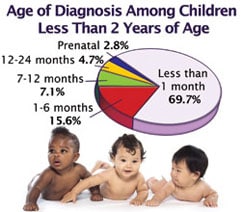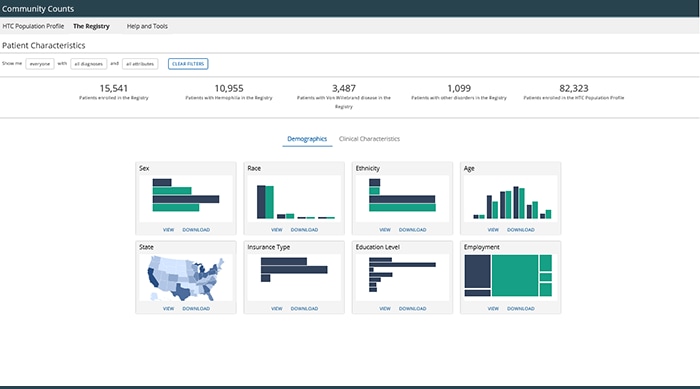Data & Statistics on Hemophilia
In the United States
- Hemophilia A affects 1 in 5,000 male births. About 400 babies are born with hemophilia A each year.
- The exact number of people living with hemophilia in the United States is not known. Based on a recent study that used data collected on patients receiving care in federally funded hemophilia treatment centers during the period 2012-2018, as many as 33,000 males in the United States are living with the disorder.
Diagnosis

- In the United States, most people with hemophilia are diagnosed at a very young age. Based on CDC data, the median age at diagnosis is 36 months for people with mild hemophilia, 8 months for those with moderate hemophilia, and 1 month for those with severe hemophilia.
- In about two thirds of cases, there is a family history of hemophilia. The diagnosis of hemophilia is made using a special blood test and most babies can be tested soon after birth. Sometimes prenatal genetic testing is done to diagnose hemophilia before birth.
- For the one-third of babies born with hemophilia in families with no known history of hemophilia, the diagnosis is made when an unusual bleeding event occurs. Special blood tests are required to make the diagnosis.
Treatment
- A CDC-sponsored randomized clinical trial found that children who were treated on a regular basis to prevent bleeding had less evidence of joint damage by 6 years of age than did those who were treated only after a bleed had started.
[Read article] - About 70% of people with hemophilia in the United States receive multidisciplinary, comprehensive care in a network of federally funded hemophilia treatment centers.
[Read article] - Mortality rates and hospitalization rates for bleeding complications from hemophilia were 40% lower among people who received care in hemophilia treatment centers than among those who did not receive this care.
[Read article]
Complications
Treatment Product Safety
- Some of the products used to treat bleeds in people with hemophilia are made from plasma from donated blood. Manufacturing and viral inactivation steps have made these products very safe. A blood safety surveillance system in place since 1998 has found no new infections with hepatitis or HIV associated with these products among hemophilia patients.
[Read article] - A recent study of young children with bleeding disorders found evidence for decreasing risk of childhood infection from plasma-derived clotting factor concentrates.
[Read article] - Hispanic patients with severe hemophilia are about twice as likely to get an inhibitor than non-Hispanic white patients.
[Read article] - A six-year study of patients in 17 US hemophilia treatment centers found that all patients with hemophilia can be at risk for an inhibitor and screening for an inhibitor is important.
[Read article]
Bleeding
- Prophylaxis decreases the risk of intracranial bleeding by 50% for people with hemophilia.
[Read article]
Joint Disease
- CDC data have shown that in addition to increasing disease severity of hemophilia, being overweight, as measured by body mass index (BMI), is strongly associated with joint mobility limitations.
[Read article]
- Rates of overweight and obesity among children and adolescents with hemophilia are similar to those among the general population, which are currently at epidemic proportions.
- A study of more than 10,000 patients enrolled in the UDC surveillance project revealed that boys and men who were overweight or obese were less likely to infuse clotting factor at home.
[Read article] - Females with Factor VIII deficiency (Hemophilia A) or Factor IX deficiency (Hemophilia B) were found to have reduced joint range of motion compared to females with no bleeding disorder.
[Read article]
Heart Disease
- People with hemophilia have unique risk factors that may predispose them to heart disease as their life expectancy increases, such as infusion of factor concentrates and infection with HIV.
[Read article]
Renal Disease
- People with hemophilia have risk factors that have been associated with acute and chronic renal disease, such as HIV infection and kidney bleeding.
[Read article]
Data from CDC’s hemophilia surveillance (health monitoring) programs have informed public health and clinical guidelines and practices to prevent or reduce hemophilia-related health problems
(Published: September 8, 2020)
A New Study of Hemophilia Occurrence Finds Many More Cases in the United States
(Published: July 1, 2020)
Key Findings: Study Shows That Regular Treatment to Prevent Bleeding Episodes Is Used Less Frequently Among Adults Than Children with Hemophilia B
(Published: December 4, 2017)
Key Findings: New Study Shows That Regular Treatment for Hemophilia Starting Early in Life Can Prevent Joint Disease
(Published: April 10, 2017)
Key Findings: New Method Designed to Detect the Type of Antibodies Linked to Inhibitor Development Among People with Hemophilia A and B
(Published: January 18, 2017)
Key Findings: Study of Hemophilia Care Outcomes over 50 Year Span Reveals Progress, Ongoing Health Challenges
(Published March 16, 2016)
Bleeding Surveillance
Learn about CDC’s past and current work in bleeding disorders.
(Published: March 16, 2020)
Women Can Have Hemophilia, Too
Learn how hemophilia is passed in families, and read Shellye’s inspirational story about her journey toward a diagnosis and treatment plan for hemophilia.
(Published: March 18, 2019)
What Is An Inhibitor?
Learn about inhibitors and read a personal story on living with an inhibitor.
(Published: March 19, 2018)
Making Strides Toward Preventing Inhibitors in Bleeding Disorders
CDC’s Division of Blood Disorders is committed to reducing the occurrence of inhibitors. Find out what they are doing to reach their goal.
(Published: April 17, 2017)
Stories of People with Hemophilia
Read and share the stories of people with hemophilia to raise awareness.
(Published: April 15, 2016)

